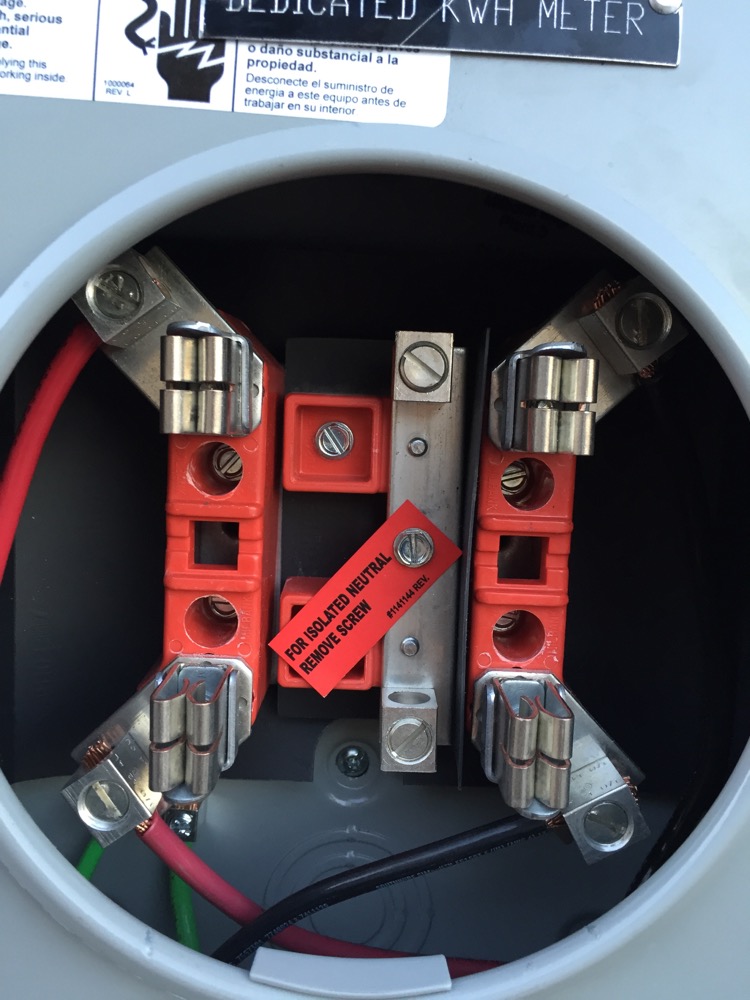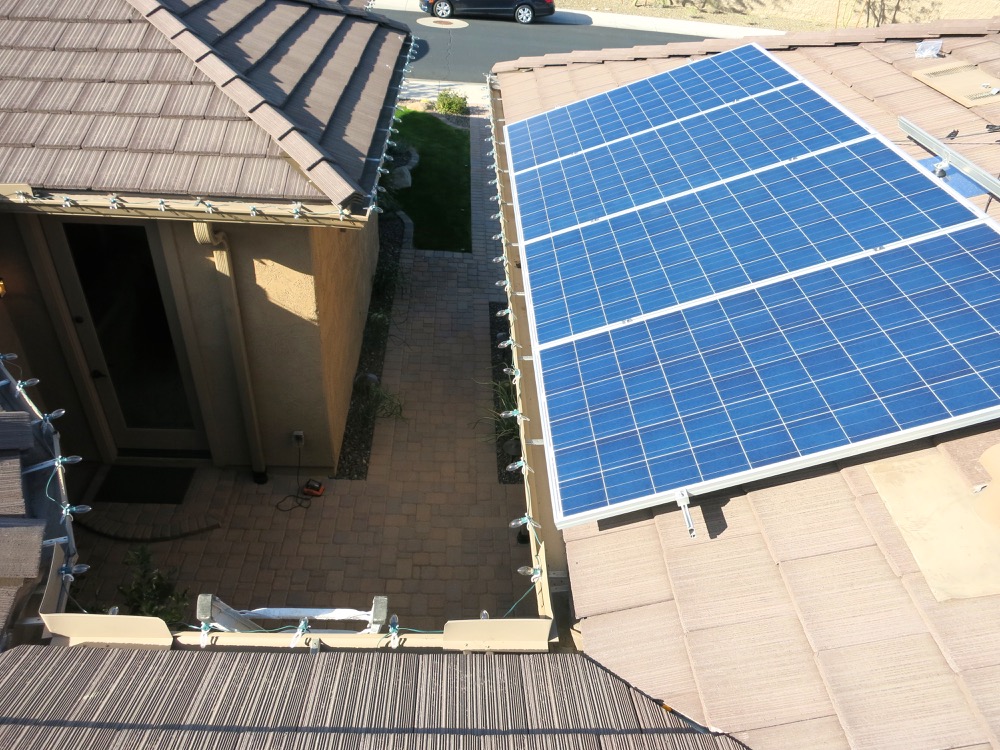Most Popular Topics
Collapse
Solar install turning out really bad - looking for some help/advice please.
Collapse
X
-
Hmm, so where should that be grounded? -
I've been following this thread for a while, glad it's finally up and running!! On a side note, I believe you are missing a ground lug in the disconnect. The conduit has a bonding bushing, but nothing on the disco itself.
BenLeave a comment:
-
Leave a comment:
-
Wonder how an "open" wiring condition could have killed the installer's voltmeter in the first place? Unless they didn't know how to use it properly and ruined it themselves somehow. Or maybe it was already busted even before that.Leave a comment:
-
To follow up on the "faulty" meter, that wasn't the problem.
The installer was supposed to come out yesterday with a new meter, of course he was a no show, so I went on Craigslist and bought one myself for $10.
Popped it in, and nothing, that wasn't the problem. So busted out the volt meter to check the connections...everything looked ok until I got to the AC disconnect panel and even in the ON position, I wasn't getting anything on the other end (top side was reading 241v). Shut off the power and checking for continuity with an ohm meter and what do you know, the left side wasn't making a connection. Looking at it closer, the "clamp" was too spread apart, so used a screw driver to bend it a bit and bam, works like a charm. Now I should probably shut it off before the electric company notices Im backfeeding power without their consent.
So busted out the volt meter to check the connections...everything looked ok until I got to the AC disconnect panel and even in the ON position, I wasn't getting anything on the other end (top side was reading 241v). Shut off the power and checking for continuity with an ohm meter and what do you know, the left side wasn't making a connection. Looking at it closer, the "clamp" was too spread apart, so used a screw driver to bend it a bit and bam, works like a charm. Now I should probably shut it off before the electric company notices Im backfeeding power without their consent. 



Leave a comment:
-
I don't know, the builder put it in there when they built the house.Leave a comment:
-
Oh, OK. I saw insulation there so I just assumed that where there is insulation, there should be radiant barrier.
There's no insulation over my garage. If your garage space is not air conditioned, wouldn't the insulation trap in the summer heat too much?Leave a comment:
-
Leave a comment:
-
I notice in a pic where your conduit comes in from the roof to the attic, that area doesn't have a radiant barrier. Is there a reason why there's no radiant barrier there?Leave a comment:
-
Yeah I guess it's accessible as in there's an access opening but there is literally almost no space up there, I can't even stand up straight in there at the highest point.Leave a comment:
-
If that attic space is accessible, I think that conduit running horizontally at a few feet above the floor is not allowed by code.
I believe the reasoning is that people might see that as a handy place to hang some clothes-hangers from for clothing their storing away for the winter/summer/whatever.
It looks fairly un-finished - so maybe it is considered not accessible and maybe you're fine.
(and I'm not sure about the rule for conduit - I know there's a rule for romex.)Leave a comment:
-
Secured the FMC to the rafters so all finished up in the attic. Also made some labels for the conduit as someone on another forum recommended to do.



Also apparently I'm good on the conduit fill even with the 3/4" the installer used outside, the permit says max allowable is 40% and I'm at 34%.

On a side note, since I was up in the attic, I notice that the people who installed my radiant barrier only cut out holes for the roof vent in 2 of the 6 spots, with one being half done. Took a few minutes and fixed all of them so now all 6 vents are open to the attic.



Leave a comment:
-
I'll be working on clamping the FMC to the rafters a bit later today.Probably.
Are you making sure that the conduit is fastened to something in reasonable spacing?
(ex. there's a conduit strap holding it in place)
I don't know the requirements for strapping/support of FMC - that's something you should go look up. And make sure you look up requirements for longer runs vs. strapping at endpoints.
the EMT sections you have will need support too - Probably since they're so short anywhere you can get a clamp/strap on them will work.
I think for EMT it's within 3' of the ends and at least once every 10 feet (if you have long runs, which you don't)
But FMC I'm sure needs more support. I ran 1" FMC like the permit specified so all should be good there.
I ran 1" FMC like the permit specified so all should be good there.
Leave a comment:
-
And finally I made them redo the conduit on the outside. Even with me watching as close as I could the whole process, the guy still snuck in 3/4" conduit instead of 1" like the permit says. Could not believe it. I even saw him with a piece of 1" in his hand, so figured it was good, and I went up on the roof to do my thing with the penetrations and when I came back down, the 3/4" was already in.
It should be fine, the conduit fill is 34% and the permit says max allowed is 31%, but old NEC code was 40% so I don't see why it would't be ok. We'll see what the inspector says, if he's good with it, I'm good with it.
At least it came out looking nice, now I have to redo my irrigation conduit because it looks like ass.



Leave a comment:
-
Install is complete!!! But, it doesn't quite work yet.
Everything got finished, we powered up the inverter, all systems ok...then got an error message:
AC Voltage Too High
The manual says that means the output voltage (from the inverter to the house service panel) measured a surge. Problem is, it killed the installer's test meter and that was that, couldn't try it again. Oh so close. They said they are coming back out tomorrow with a new meter. I called SolarEdge and they said we need a new meter to run some tests...it could be a faulty inverter transformer, would be my luck.
Anyway, progress photos from today...
Started out by finishing up the roof penetration for the conduit...

Used the same sealing method that I did on the standoffs...

Bit more goo inside the hole for extra measure...

And some more on top too, finished product...

Inside the attic I secured the conduit to a rafter and put some sealant from this side too.

For the other one though, it didn't end up next to a rafter, so I put in a piece of 2x4 between the rafters to secure the conduit.

Ran the FMC through the wall and then the wiring was pulled by the installer.

Wiring all pulled and connected inside the combiner box.

I took a voltage reading at the 11 panel string and got 11.1VDC, just like I should. With the power optimizers, they output 1v each until the inverter is turned on. Makes it safe and easy to make sure all the panels in the string are properly wired.

Now back to the panels above the gutter from yesterday...
Not only were they above the gutter, but they didn't install the mid-clamps correctly.

These are supposed to go vertically, not horizontally, so that the sharp ends puncture through the anodized coating and ground the panel, like this...

So with that, we redid all of them, put the clamps the correct way, moved them up and all looks great now.


Leave a comment:
Leave a comment: